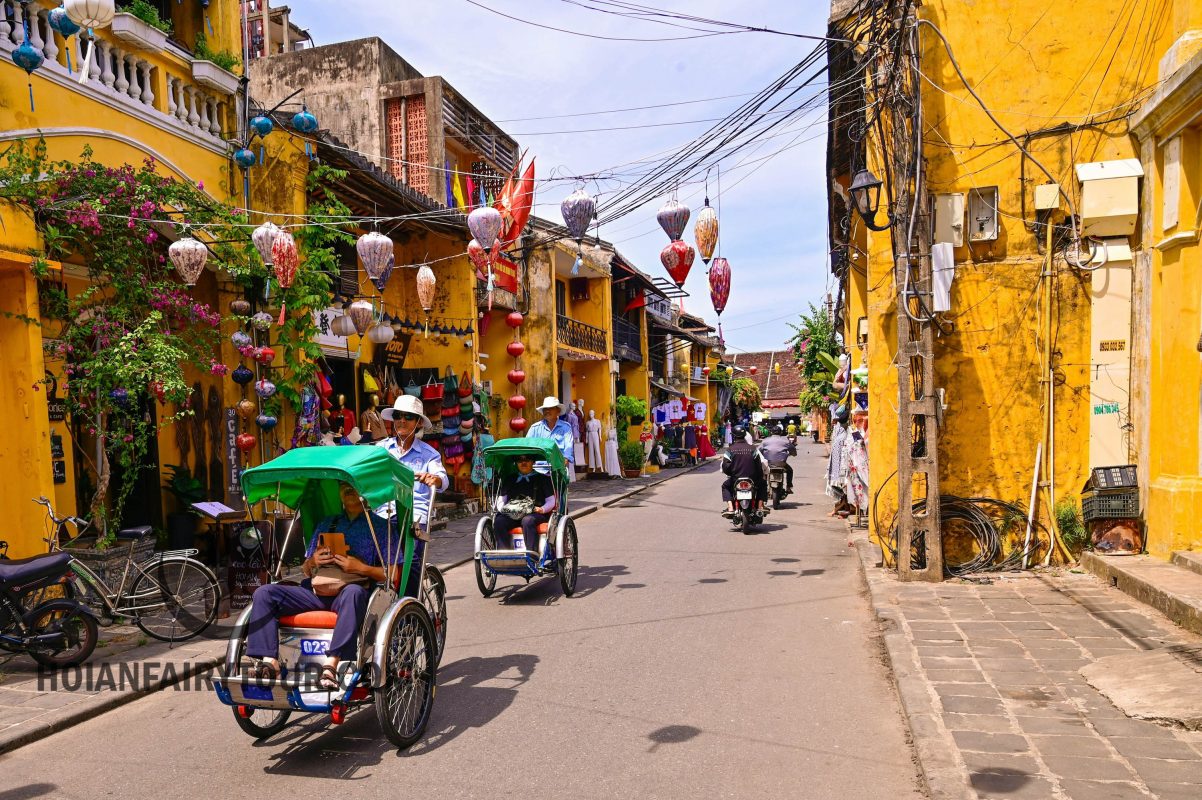Hoi An is known as a city possessing peace, a place where history, culture, and natural beauty converge. That’s why Hoi An continues to attract an increasing number of tourists from around the world, and concerns about safety naturally arise. Is Hoi An a safe place to visit? The answer, generally, is yes. Hoi An is considered one of the safest destinations in Vietnam, thanks to its low crime rate, strong community ties, and the efforts of local authorities. However, like any travel destination, it’s important for visitors to stay informed and take precautions. This essay will explore the safety of Hoi An in detail, including data on crime, the town’s safety achievements, common crimes, and tips for staying safe.
1 – Brief Overview of Safety in Hoi An
Hoi An is a small town with a population of around 120,000 people. To answer the question is it safe in Hoi An?, Hoi An (Vietnam) has a crime rate of 6.25, much lower than Lima (Peru), which has the highest crime rate at 84.51.
“You don’t have to worry about pickpocketing, assault, kidnapping, or harm during your trip. Hoi An is one of those destinations,” emphasized Smoky Mountains.
Hoi An is generally regarded as one of the safest places in Vietnam. The town’s low crime rate is a significant factor contributing to its reputation as a safe destination. Violent crime is extremely rare, and the majority of visitors enjoy their stay without any incidents. The local government has taken measures to ensure the safety and security of both residents and tourists, making Hoi An a welcoming and secure environment.

2 – Data on Crime in Hoi An
Is it safe in Hoi An? In general, crime in Hoi An is relatively low compared to larger Vietnamese cities like Hanoi or Ho Chi Minh City. The most common crimes in Hoi An are non-violent and often involve petty theft, such as pickpocketing or bag snatching. These incidents tend to occur in crowded areas, especially during festivals or events when the town is bustling with tourists. However, such crimes are not widespread, and with basic precautions, most visitors can avoid becoming victims.
A study conducted by the Vietnam Institute for Tourism Development Research highlighted that the rate of crime affecting tourists in Hoi An is lower than in many other tourist destinations in the region. The town’s small size and close-knit community contribute to a higher level of social control, reducing the likelihood of crime. Additionally, the presence of local law enforcement and security personnel in key areas adds an extra layer of protection for visitors.
3 – Hoi An’s Safety Achievements
Hoi An has received recognition for its safety and has achieved several accolades that highlight its status as a secure destination. One of the most significant titles that Hoi An has earned is its inclusion in various lists of the safest cities and towns in Southeast Asia. For example, Hoi An has been featured in the “Top 10 Safest Cities in Asia” by numerous travel publications, which praise the town’s low crime rate, friendly atmosphere, and well-maintained public spaces.
The town’s safety is also reflected in its tourism industry. Hoi An has consistently been ranked as one of the best destinations in the world by travel magazines such as Travel + Leisure and Condé Nast Traveler. These rankings often consider factors like safety, hospitality, and the overall experience of visitors. The fact that Hoi An continues to be a top choice for travelers speaks volumes about its reputation as a safe and secure place.
Moreover, Hoi An’s local government has been proactive in promoting safety through various initiatives. For instance, the town has implemented strict regulations to ensure the safety of its visitors, such as limiting motorbike traffic in the ancient town during peak tourist hours. This measure not only enhances the pedestrian experience but also reduces the risk of accidents and improves overall safety. Additionally, the local authorities have established a tourist police force dedicated to assisting visitors and addressing any safety concerns that may arise.
4 – Common Crimes in Hoi An

While Hoi An is generally safe, visitors should be aware of some common crimes that could occur, particularly petty theft. Understanding these risks can help tourists take necessary precautions and enjoy their stay without incident.
a. Petty Theft – is it safe in Hoi An?
Petty theft is the most common crime in Hoi An. This typically includes pickpocketing, bag snatching, and other forms of theft targeting tourists. These incidents are more likely to occur in crowded areas, such as the night market, the ancient town, or during festivals when there are large gatherings of people. To minimize the risk, visitors should keep their valuables secure, avoid carrying large sums of money, and be cautious when using their phones or cameras in public.
b. Scams – is it safe in Hoi An?
Scams are another concern for tourists in Hoi An, though they are less common than in larger cities. Common scams may involve overcharging for goods or services, especially when it comes to transportation or guided tours. For example, some tourists have reported being charged excessively for taxi rides or boat trips. To avoid falling victim to scams, it is advisable to agree on a price beforehand, use reputable service providers, and be cautious of offers that seem too good to be true.
c. Motorbike Thefts – is it safe in Hoi An?
Motorbike thefts can occur in Hoi An, although they are not as prevalent as in other parts of Vietnam. Tourists who rent motorbikes should be mindful of where they park and ensure that the vehicle is securely locked when not in use. It is also recommended to park in designated areas with security personnel.
d. Fake Goods – is it safe in Hoi An?
Hoi An is known for its tailors and shops selling various goods, including clothing, souvenirs, and handicrafts. However, tourists should be aware of the potential for counterfeit products. Some vendors may sell fake branded goods or low-quality items at inflated prices. To avoid purchasing fake products, it is advisable to shop at reputable stores and do some research beforehand.
e. Environmental Risks – is it safe in Hoi An?
While not a crime, it is worth mentioning that Hoi An can experience environmental risks such as flooding, particularly during the rainy season from October to December. These natural events can disrupt travel plans and pose safety risks, especially in low-lying areas. Visitors should stay informed about weather conditions and follow any advisories issued by local authorities.
5 – 10 Tips to Protect Yourself in Hoi An
Staying safe in Hoi An is largely a matter of common sense and taking simple precautions. Here are ten tips to help visitors protect themselves and enjoy a worry-free experience in this beautiful town:
5.1. Stay Aware of Your Surroundings – is it safe in Hoi An?
Always be mindful of your surroundings, especially in crowded areas. Pay attention to your belongings and be cautious of anyone who seems overly interested in your movements.
5.2. Use a Money Belt or Secure Bag – is it safe in Hoi An?
To prevent pickpocketing, use a money belt or a secure, cross-body bag that is difficult for thieves to access. Keep your bag close to your body and avoid carrying valuables in easily accessible pockets.
5.3. Avoid Flashing Valuables – is it safe in Hoi An?
Avoid displaying expensive items such as jewelry, cameras, or large amounts of cash. This can attract unwanted attention from potential thieves.
5.4. Choose Reputable Service Providers – is it safe in Hoi An?
Whether you’re booking a tour, renting a motorbike, or taking a taxi, choose reputable service providers with positive reviews. This reduces the risk of being overcharged or scammed.
5.5. Be Cautious with Street Vendors – is it safe in Hoi An?
When shopping at street markets or dealing with vendors, be cautious and negotiate prices upfront. Be aware of the possibility of counterfeit goods and only purchase from trustworthy sellers.
5.6. Lock Your Accommodation – is it safe in Hoi An?
Ensure that your accommodation is secure by locking doors and windows when you leave. If staying in a hotel, use the safe provided for storing valuables.
5.7. Take Care with Motorbikes – is it safe in Hoi An?
If renting a motorbike, always wear a helmet, follow traffic rules, and park in secure, designated areas. Be cautious when driving, as traffic can be unpredictable.
5.8. Stay Informed About Weather Conditions – is it safe in Hoi An?
If you are visiting Hoi An during the rainy season, stay informed about weather conditions and be prepared for the possibility of flooding. Follow any safety advisories issued by local authorities.
5.9. Respect Local Customs and Laws – is it safe in Hoi An?
Respecting local customs and laws can help you avoid unnecessary trouble. Dress modestly when visiting religious sites, and be aware of regulations regarding behavior in public spaces.
5.10. Keep Emergency Contacts Handy – is it safe in Hoi An?
Carry a list of emergency contacts, including the local police, your embassy, and your accommodation. In case of an emergency, you will have the information you need to get help quickly.
6. Solution for tourists if their items are lost or stolen
6.1. Stay Calm and Assess the Situation – – is it safe in Hoi An?
Take a moment to Identify all the items that were lost or stolen, such as a wallet, passport, phone, or any other valuable items.
6.2 Inform Your Accommodation – is it safe in Hoi An?
Notify Hotel Staff: Inform the management of your hotel or guesthouse about the incident. They can assist you in contacting local authorities and may have additional security measures in place to help prevent further loss.
Check Lost and Found: Sometimes, lost items are found by other guests or staff and turned into the hotel’s lost and found department.
6.3 Check Nearby Locations – is it safe in Hoi An?
Retrace Your Steps: Go back to the places you visited before realizing your items were missing. Ask staff at restaurants, shops, or other locations if they found or were handed any lost items.
Public Announcements: In some cases, making a public announcement in the area where you think the item was lost could lead to its recovery, especially if it was misplaced rather than stolen.
6.4 Seek Help from Local Tourism Services – is it safe in Hoi An?
Tourist Police: Hoi An has tourist police who are specifically there to assist visitors. They may be able to provide additional help in recovering lost items or dealing with theft.
Tourist Information Centers: These centers can offer advice on how to proceed and may have resources or contacts that can assist you.
Hotline for Tourist
This center will operate continuously every day of the week, including Saturday, Sunday, holidays, and Tet. All contact information, requests, and feedback from tourists and businesses will be received by the Center via hotline 05103.666.333, or at the address: 47 Phan Chu Trinh Street, City. Hoi An.
Outbound Links
For more information on planning your trip to Hoi An, check out these helpful resources:
Convenient Services at Hoi An Fairy Tour
To fully enjoy these local-only restaurant in Hoi An, consider the convenient services offered by Hoi An Fairy Tour. Whether you need a taxi, a guided tour, motorbike rental, a sleeper bus, or a boat to Cham Island, they provide reliable and affordable options to make your culinary adventure hassle-free.
From Vincent – the Author
If you find this post useful and would like to show your appreciation, you can support me by making a donation via PayPal. Your generosity helps me continue creating helpful content. Thank you!
Paypal Link: [Click here]
HOI AN FAIRY TOUR – HOME – TAXI – TOUR/SHOW – BIKE/BUS/BOAT – LOCAL RECOMMENED
